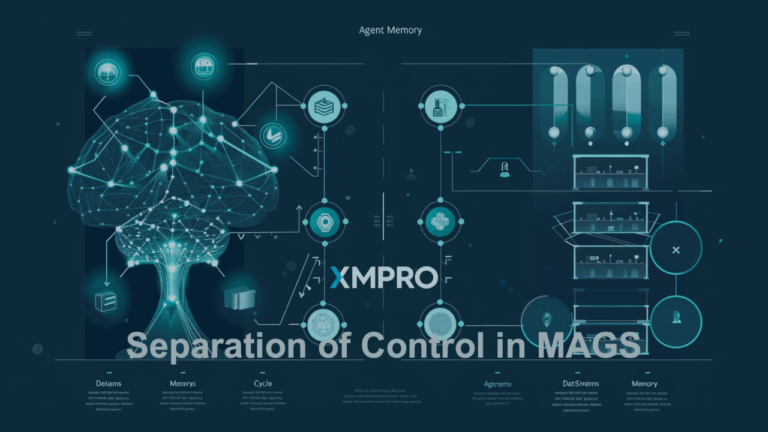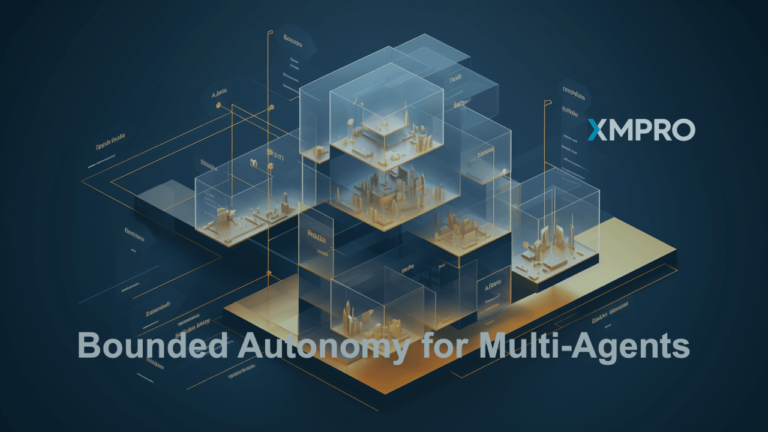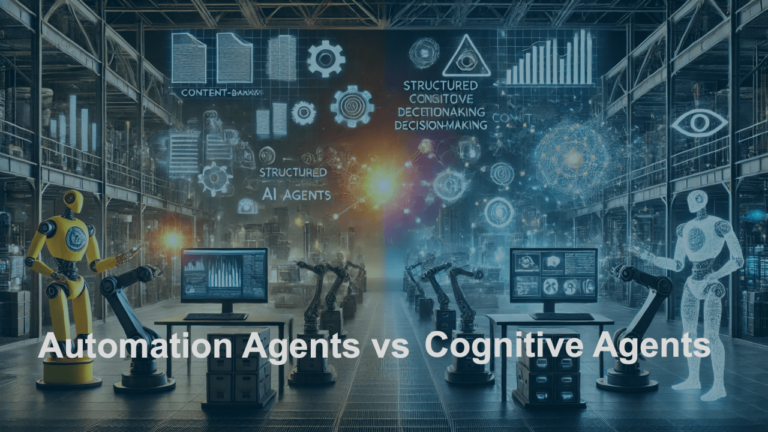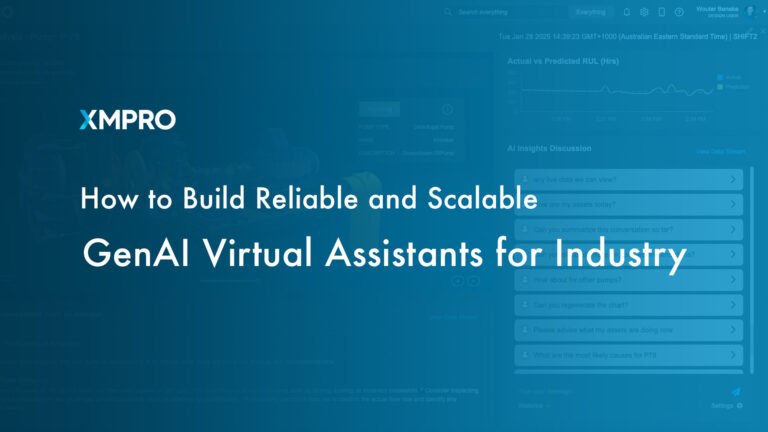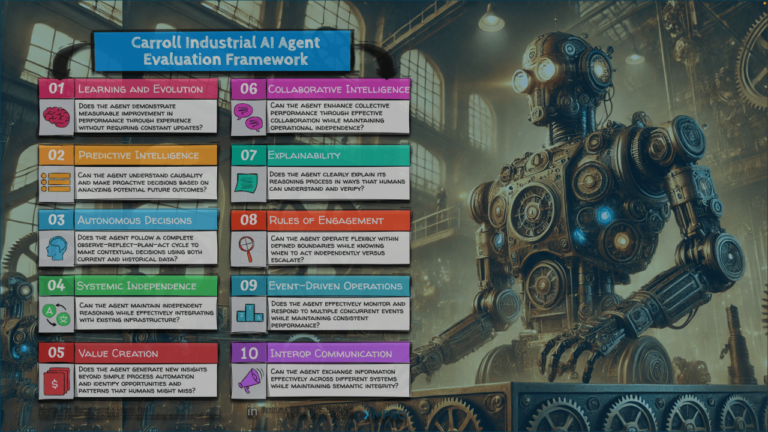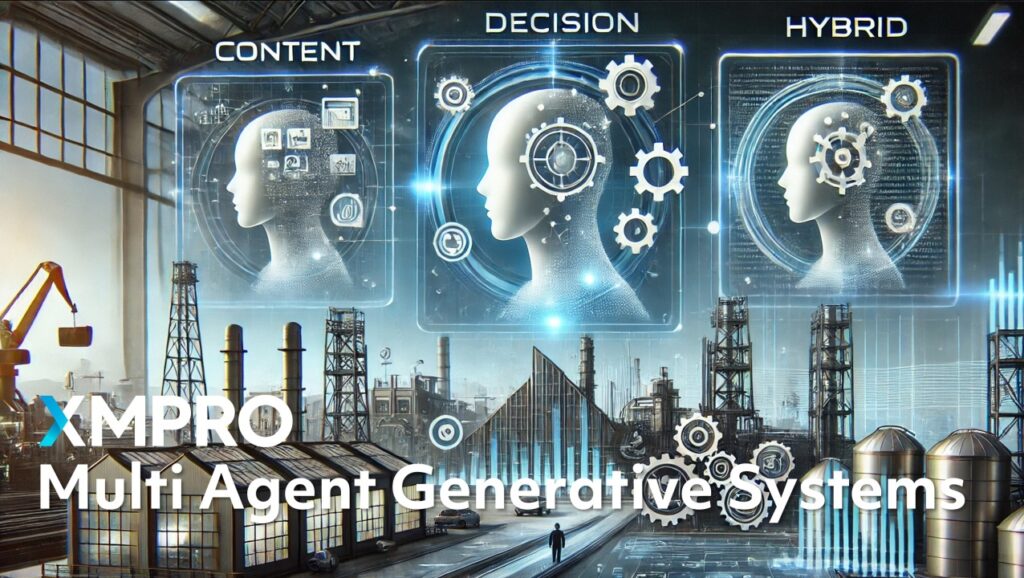Content, Decision, and Hybrid: The Three Pillars of Multi-Agent Systems in Industry

Pieter Van Schalkwyk
CEO at XMPRO, Author – Building Industrial Digital Twins, DTC Ambassador, Co-chair for AI Joint Work Group at Digital Twin Consortium
ChatGPT and other LLM tools like Claude and Perplexity have captured the minds of individuals. Those who are becoming power users are seeing a significant impact in productivity and efficiency for content research, creation, and curation tasks.
There are also those who dabbled a bit, attempted a few novelty questions, or tried to use it as a calculator. When they didn’t get the answer they expected, they assumed it was wrong, wrote it off, and moved on. But that’s a topic for a future post.
For those of us who now use it as a daily assistant with content-based tasks and are getting more experienced with asking the right questions (prompting), it has increased the efficiency of knowledge tasks by 10x + . It’s “kinda like” having an intern who can help me research faster, take my bullet notes, and turn them into Flesch-Kincaid Grade 10 level material. This material is neatly formatted in 15-20 words per sentence and 3-5 sentences per paragraph for a skeptical engineering audience. Just like the content you are reading now (;
This is great at an individual level, but how does this translate to businesses looking for 10x improvements in business process productivity? One popular solution at the moment is to put “Copilot” capability into every business application and productivity tool. This helps create emails faster, brainstorm presentations, and use natural language to query any data source in the business in real time. Users don’t have to wait for IT to write a report in the ERP system to get what they’re looking for. But in a way, this is just a better mousetrap, or in Henry Ford’s words, faster horses. It is very useful, but like many other tools, this provides incremental productivity gains in a business context.
Another solution gaining popularity fast is the concept of generative “agents”. Dr. Andrew Ng , the founding lead of the Google Brain team, and many other AI luminaries are highlighting the potential of Agentic AI to change the way business processes work.
Is it possible to replicate the “personal use” scenario using virtual employees, aka “agents,” that can perform tasks humans need help with or that humans find challenging to do or really suck at?
It turns out that generative agents can do exactly that, and are really good at it. Sergey Malygin , CEO at SODA.auto, an automotive startup out of the UK, shared an example with me. In their process of generating specification documentation, they’re achieving 80% faster shipping of Feature Library documentation with 90% less human work time. Human engineers still review the specification, which they enjoy more than the painstaking process of creating the content. This is a perfect example of a content agent at work.
But not all work in business processes is content work. Most industrial processes are not about content creation and curation, but about using large volumes of content to reason and make decisions based on real-time observations, reflections, and context. The tasks are not content tasks, but decision tasks. We call these agents that use LLMs for this reasoning and decision capabilities “Decision Agents“. The foundational research for how this works is out of Stanford. You can find a link in the resources section at the end of this article.
The Untapped Potential of Decision Agents in Industrial MAGS
While much of the current market focus on Multi-Agent Generative Systems centers on Content Agents, the real game-changer for industrial applications lies in Decision Agents. Content Agents, which create and curate information using Large Language Models (LLMs), have dominated early examples and discussions. However, these applications often limit themselves to hierarchical or procedural processes, missing the true potential of AI in industry.
The key to significant productivity improvements in industrial settings lies in leveraging Decision Agents powered by LLMs. These agents excel at tasks that humans typically struggle with, particularly in consuming and processing vast amounts of information for reflection and decision-making. This capability aligns perfectly with the complex, non-deterministic nature of many industrial processes.
In industrial applications, the primary challenge often involves observing real-time inputs and making swift, accurate decisions on the next process step. Unlike the procedural workflows where Content Agents shine, industrial processes are frequently dynamic and unpredictable. The task at hand is not so much about creating or curating content, but about making informed decisions in rapidly changing environments.
In the next section I will expand on Content Agents, Decision Agents, and also introduce Hybrid Agents for processes that can benefit from agents with both content and reasoning capabilities.
The Triad of AI Agents Reshaping Industrial Operations
Multi-Agent Generative Systems are reshaping industrial operations by integrating three distinct types of AI agents: Content Agents, Decision Agents, and Hybrid Agents.

Each agent type brings unique capabilities to the table, working in concert to optimize complex industrial processes. This article explores the roles and applications of these agents, highlighting their importance in modern industrial settings.
Content Agents: The Information Specialists
Content Agents excel at gathering, analyzing, and producing information. They sift through vast amounts of data, create reports, and maintain knowledge bases crucial for industrial operations. These agents often serve as researchers, writers, and information curators within the system. In industrial applications, Content Agents might compile maintenance logs, generate safety protocols, or create technical documentation and specifications for equipment.
Typical Roles:
Research Specialist
- Content: Gathers, analyzes, and synthesizes information from diverse sources to create comprehensive research reports.
- Action: Conducts systematic literature reviews, performs data analysis, and compiles findings into structured reports.
Content Creator
- Content: Produces original, engaging content across various formats (text, visual, audio) tailored to specific audiences.
- Action: Writes articles, designs infographics, records podcasts, and develops multimedia presentations to communicate ideas effectively.
Content Curator
- Content: Organizes and categorizes existing content, creating structured collections and knowledge bases.
- Action: Tags and categorizes content, creates thematic collections, and develops content taxonomies to improve information accessibility.
Decision Agents: The Strategic Thinkers
Decision Agents form the backbone of MAGS in industrial settings, typically comprising 60%-70% of the agent team. These agents specialize in analyzing data, evaluating options, and making informed decisions. They use their deep knowledge of processes, quality standards, and operational metrics to guide actions. In a factory setting, Decision Agents might optimize production schedules, manage resource allocation, or determine maintenance priorities based on equipment performance data.
Typical Roles:
Decision SME (like Quality Engineer)
- Knowledge: Possesses deep understanding of quality standards, process optimization techniques, and industry best practices.
- Decision: Evaluates processes against quality standards and makes decisions on corrective actions.
Planners
- Knowledge: Holds comprehensive knowledge of project management methodologies, resource allocation strategies, and risk assessment techniques.
- Decision: Determines optimal strategies for resource allocation and prioritizes tasks within projects.
Managers
- Knowledge: Maintains broad knowledge of organizational operations, performance metrics, and strategic management principles.
- Decision: Makes operational decisions based on performance data and aligns team activities with organizational goals.
Hybrid Agents: The Versatile Problem-Solvers
Hybrid Agents combine the strengths of both Content and Decision Agents. They can both process information and make complex decisions, making them invaluable for tasks that require a holistic approach. In industrial applications, Hybrid Agents often tackle roles such as Design Creators, Decison Curators, or Auditors. They might develop new production methods, optimize knowledge distribution across departments, or manage complex risk assessment processes.
Typical Roles:
Design Creator
- Content: Synthesizes diverse information to create detailed proposals and prototypes for innovative solutions.
- Decision: Evaluates and prioritizes innovation initiatives based on feasibility, market potential, and organizational alignment.
Decision Curators
- Content: Curates and organizes vast amounts of information into accessible knowledge bases and learning materials.
- Decision: Determines optimal knowledge distribution strategies and prioritizes knowledge gap remediation efforts.
Auditors
- Content: Compiles and analyzes complex data sets to produce comprehensive risk assessment reports and compliance documentation.
- Decision: Evaluates risk significance and determines appropriate mitigation strategies and policy changes.
Composition of Agent Teams in Industrial Applications
In typical industrial processes, the composition of agent teams often follows a 20-70-10 split: 20% Content Agents, 70% Decision Agents, and 10% Hybrid Agents. This distribution reflects the critical nature of decision-making in industrial operations. While information gathering and content creation are essential, the ability to make rapid, accurate decisions based on that information is paramount in industrial settings.
The Untapped Potential of Decision Agents in Industrial MAGS
Decision Agents excel in their ability to observe, reflect, plan, and act on vast amounts of data, far surpassing human cognitive limits. These agents can continuously monitor real-time inputs from industrial processes while simultaneously accessing and interpreting extensive Retrieval-Augmented Generation (RAG) information, such as standard operating procedures, historical data, and best practices.
In a chemical plant scenario, a Decision Agent observes real-time data on reaction conditions, product quality metrics, and equipment performance. It then reflects on this information, comparing it against historical trends and RAG data on optimal process parameters. The agent plans adjustments, considering potential outcomes and aligning with safety protocols and production goals. Finally, it acts by implementing precise, real-time modifications to process parameters, optimizing yield and efficiency beyond human capabilities.
For predictive maintenance, Decision Agents observe current equipment performance data and environmental conditions. They reflect on this information alongside historical maintenance records and manufacturer specifications retrieved through RAG. The planning phase involves assessing the urgency of maintenance needs, potential failure modes, and optimal timing to minimize disruption. The agent then acts by scheduling maintenance interventions, balancing the risks of equipment failure against unnecessary downtime.
In supply chain management, Decision Agents observe global market trends, inventory levels, production capacities, and logistics data. They reflect on this information in conjunction with RAG data on supplier performance, contractual obligations, and demand forecasts. The planning phase involves complex scenario modeling, considering multiple variables to optimize procurement, production, and distribution strategies. The agent then acts by making data-driven decisions on inventory management, supplier selection, and distribution routing, enhancing supply chain resilience and efficiency.
This observe-reflect-plan-act cycle, powered by the integration of real-time data and comprehensive RAG information, enables Decision Agents to make nuanced, context-aware decisions in complex industrial environments. Their ability to process and synthesize information from diverse sources allows for more informed and effective decision-making than traditional rule-based systems or human operators alone.
As industries look to implement MAGS, they should focus on developing and deploying sophisticated Decision Agents. While Content Agents have their place, the true transformation in industrial productivity will come from AI that can make complex decisions in dynamic environments. By shifting focus to Decision Agents, companies can unlock new levels of efficiency, adaptability, and innovation in their industrial processes.
If this excites you and you want to be part of the next evolution in industrial applications, please reach out to me or Gavin Green , VP Strategic Solutions.
We are opening limited pilot opportunities for innovative, agile leaders in the industry.
PS – My Prompt for improving the readability of this post

Prompt Generation Tuner 🙂 by DALL-E
Rewrite this section of a LinkedIn article on Multi Agent Generative Systems. Do not change the content and meaning, just improve grammar and readability.
- Audience: Target senior managers and technical readers
- Aim for 15-20 words per sentence
- Aim for 3-5 sentences per paragraph
- Use the Flesch-Kincaid Grade Level to gauge readability.
- Aim for a Grade Level of 10 for a skeptical engineering Audience
- Maintain a Professional Tone that avoid marketing jargon.
- Use an Active Voice and write in the voice of Pieter van Schalkwyk, CEO at XMPro.
Avoid words like “realm”, “poised”, “paradigms”, “pivotal”, “delves”, “cutting-edge”, “elevate”, “unprecedented”, “revolutionize”, “enhance”
<article>
</article>
Article Resources
SODA Link: https://soda.auto/blog/soda-multi-agent-systems-mags-implementation/
Simulacra Link: https://arxiv.org/abs/2304.03442











